I have code written for this problem but I am struggling fin
I have code written for this problem but I am struggling finishing it so I am hoping to see it done in a perhaps different way than how I approached it. Here is the question:
Write a program which implements Huffman Encoding assuming a code alphabet of Z2, ie, binary codewords. Start with a class called HuffmanNode.java, which contains the required fields S, P, C, L, as well as a left and a right child HuffmanNode. The algorithm should proceed as follows: First, the user selects a text file, which is read into your program. Each line of the text file will have a symbol, sk S, and a probability, pk P. Each line should be written to a distinct HuffmanNode, (leaving Ck and lk blank for later). The newly semi-filled HuffmanNodes should be added, in increasing order of pk into a HuffmanNode list: an ArrayList of HuffmanNodes. Then the Huffman tree is created by following the Huffman Algorithm. After the tree is created, the tree is traversed recursively in order that the codewords and lengths may be added to the HuffmanNodes. Finally, print your symbols and codes to the screen or to a file for verification. Also, you should traverse your Huffman Tree in order to compute the average codeword length of your new code, (the ACWL(C)).
Solution
// C program for Huffman Coding
#include <stdio.h>
#include <stdlib.h>
// This constant can be avoided by explicitly calculating height of Huffman Tree
#define MAX_TREE_HT 100
// A Huffman tree node
struct MinHeapNode
{
char data; // One of the input characters
unsigned freq; // Frequency of the character
struct MinHeapNode *left, *right; // Left and right child of this node
};
// A Min Heap: Collection of min heap (or Hufmman tree) nodes
struct MinHeap
{
unsigned size; // Current size of min heap
unsigned capacity; // capacity of min heap
struct MinHeapNode **array; // Attay of minheap node pointers
};
// A utility function allocate a new min heap node with given character
// and frequency of the character
struct MinHeapNode* newNode(char data, unsigned freq)
{
struct MinHeapNode* temp =
(struct MinHeapNode*) malloc(sizeof(struct MinHeapNode));
temp->left = temp->right = NULL;
temp->data = data;
temp->freq = freq;
return temp;
}
// A utility function to create a min heap of given capacity
struct MinHeap* createMinHeap(unsigned capacity)
{
struct MinHeap* minHeap =
(struct MinHeap*) malloc(sizeof(struct MinHeap));
minHeap->size = 0; // current size is 0
minHeap->capacity = capacity;
minHeap->array =
(struct MinHeapNode**)malloc(minHeap->capacity * sizeof(struct MinHeapNode*));
return minHeap;
}
// A utility function to swap two min heap nodes
void swapMinHeapNode(struct MinHeapNode** a, struct MinHeapNode** b)
{
struct MinHeapNode* t = *a;
*a = *b;
*b = t;
}
// The standard minHeapify function.
void minHeapify(struct MinHeap* minHeap, int idx)
{
int smallest = idx;
int left = 2 * idx + 1;
int right = 2 * idx + 2;
if (left < minHeap->size &&
minHeap->array[left]->freq < minHeap->array[smallest]->freq)
smallest = left;
if (right < minHeap->size &&
minHeap->array[right]->freq < minHeap->array[smallest]->freq)
smallest = right;
if (smallest != idx)
{
swapMinHeapNode(&minHeap->array[smallest], &minHeap->array[idx]);
minHeapify(minHeap, smallest);
}
}
// A utility function to check if size of heap is 1 or not
int isSizeOne(struct MinHeap* minHeap)
{
return (minHeap->size == 1);
}
// A standard function to extract minimum value node from heap
struct MinHeapNode* extractMin(struct MinHeap* minHeap)
{
struct MinHeapNode* temp = minHeap->array[0];
minHeap->array[0] = minHeap->array[minHeap->size - 1];
--minHeap->size;
minHeapify(minHeap, 0);
return temp;
}
// A utility function to insert a new node to Min Heap
void insertMinHeap(struct MinHeap* minHeap, struct MinHeapNode* minHeapNode)
{
++minHeap->size;
int i = minHeap->size - 1;
while (i && minHeapNode->freq < minHeap->array[(i - 1)/2]->freq)
{
minHeap->array[i] = minHeap->array[(i - 1)/2];
i = (i - 1)/2;
}
minHeap->array[i] = minHeapNode;
}
// A standard funvtion to build min heap
void buildMinHeap(struct MinHeap* minHeap)
{
int n = minHeap->size - 1;
int i;
for (i = (n - 1) / 2; i >= 0; --i)
minHeapify(minHeap, i);
}
// A utility function to print an array of size n
void printArr(int arr[], int n)
{
int i;
for (i = 0; i < n; ++i)
printf(\"%d\", arr[i]);
printf(\"\ \");
}
// Utility function to check if this node is leaf
int isLeaf(struct MinHeapNode* root)
{
return !(root->left) && !(root->right) ;
}
// Creates a min heap of capacity equal to size and inserts all character of
// data[] in min heap. Initially size of min heap is equal to capacity
struct MinHeap* createAndBuildMinHeap(char data[], int freq[], int size)
{
struct MinHeap* minHeap = createMinHeap(size);
for (int i = 0; i < size; ++i)
minHeap->array[i] = newNode(data[i], freq[i]);
minHeap->size = size;
buildMinHeap(minHeap);
return minHeap;
}
// The main function that builds Huffman tree
struct MinHeapNode* buildHuffmanTree(char data[], int freq[], int size)
{
struct MinHeapNode *left, *right, *top;
// Step 1: Create a min heap of capacity equal to size. Initially, there are
// modes equal to size.
struct MinHeap* minHeap = createAndBuildMinHeap(data, freq, size);
// Iterate while size of heap doesn\'t become 1
while (!isSizeOne(minHeap))
{
// Step 2: Extract the two minimum freq items from min heap
left = extractMin(minHeap);
right = extractMin(minHeap);
// Step 3: Create a new internal node with frequency equal to the
// sum of the two nodes frequencies. Make the two extracted node as
// left and right children of this new node. Add this node to the min heap
// \'$\' is a special value for internal nodes, not used
top = newNode(\'$\', left->freq + right->freq);
top->left = left;
top->right = right;
insertMinHeap(minHeap, top);
}
// Step 4: The remaining node is the root node and the tree is complete.
return extractMin(minHeap);
}
// Prints huffman codes from the root of Huffman Tree. It uses arr[] to
// store codes
void printCodes(struct MinHeapNode* root, int arr[], int top)
{
// Assign 0 to left edge and recur
if (root->left)
{
arr[top] = 0;
printCodes(root->left, arr, top + 1);
}
// Assign 1 to right edge and recur
if (root->right)
{
arr[top] = 1;
printCodes(root->right, arr, top + 1);
}
// If this is a leaf node, then it contains one of the input
// characters, print the character and its code from arr[]
if (isLeaf(root))
{
printf(\"%c: \", root->data);
printArr(arr, top);
}
}
// The main function that builds a Huffman Tree and print codes by traversing
// the built Huffman Tree
void HuffmanCodes(char data[], int freq[], int size)
{
// Construct Huffman Tree
struct MinHeapNode* root = buildHuffmanTree(data, freq, size);
// Print Huffman codes using the Huffman tree built above
int arr[MAX_TREE_HT], top = 0;
printCodes(root, arr, top);
}
// Driver program to test above functions
int main()
{
char arr[] = {\'a\', \'b\', \'c\', \'d\', \'e\', \'f\'};
int freq[] = {5, 9, 12, 13, 16, 45};
int size = sizeof(arr)/sizeof(arr[0]);
HuffmanCodes(arr, freq, size);
return 0;
}
Output:
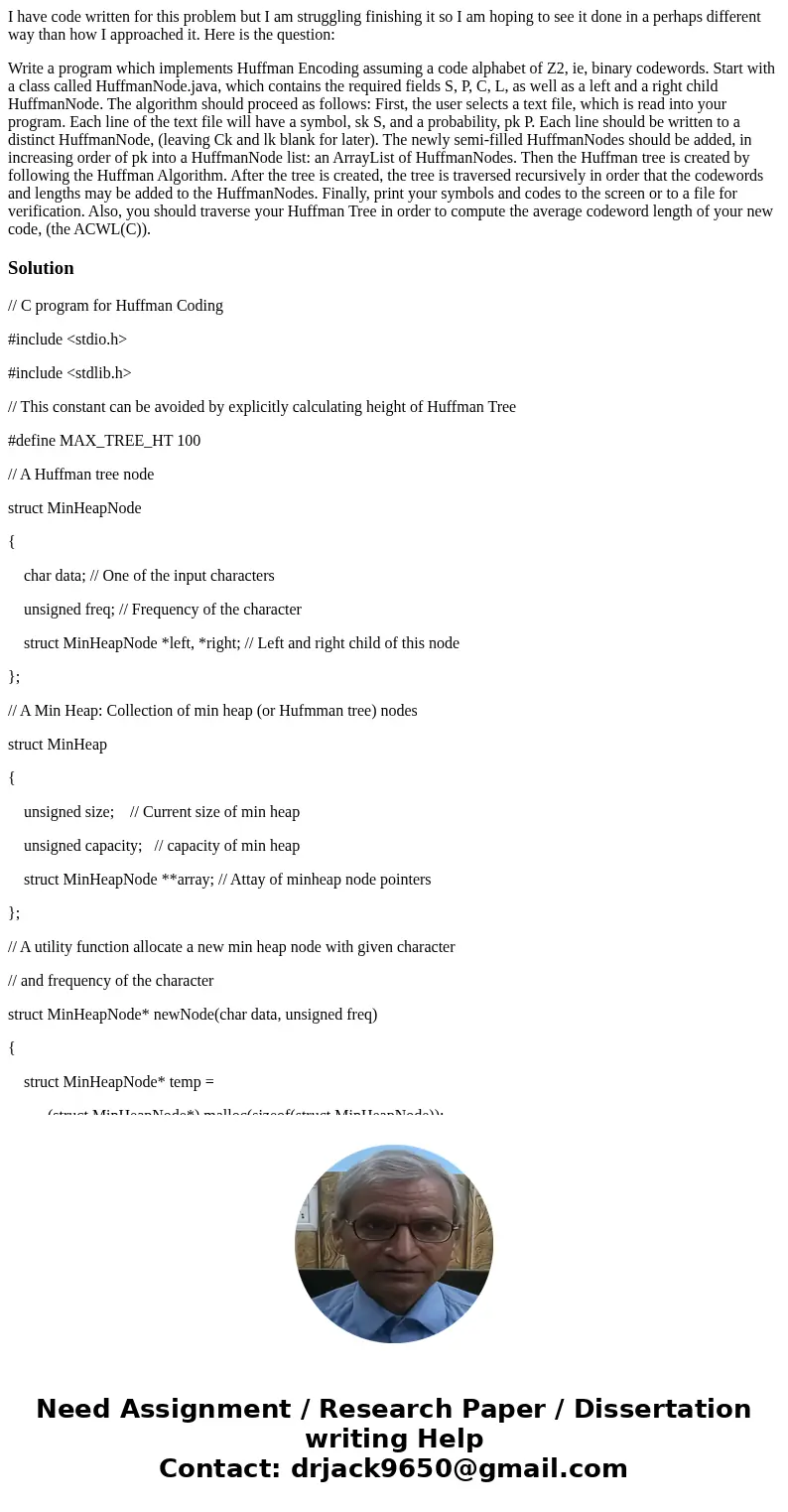
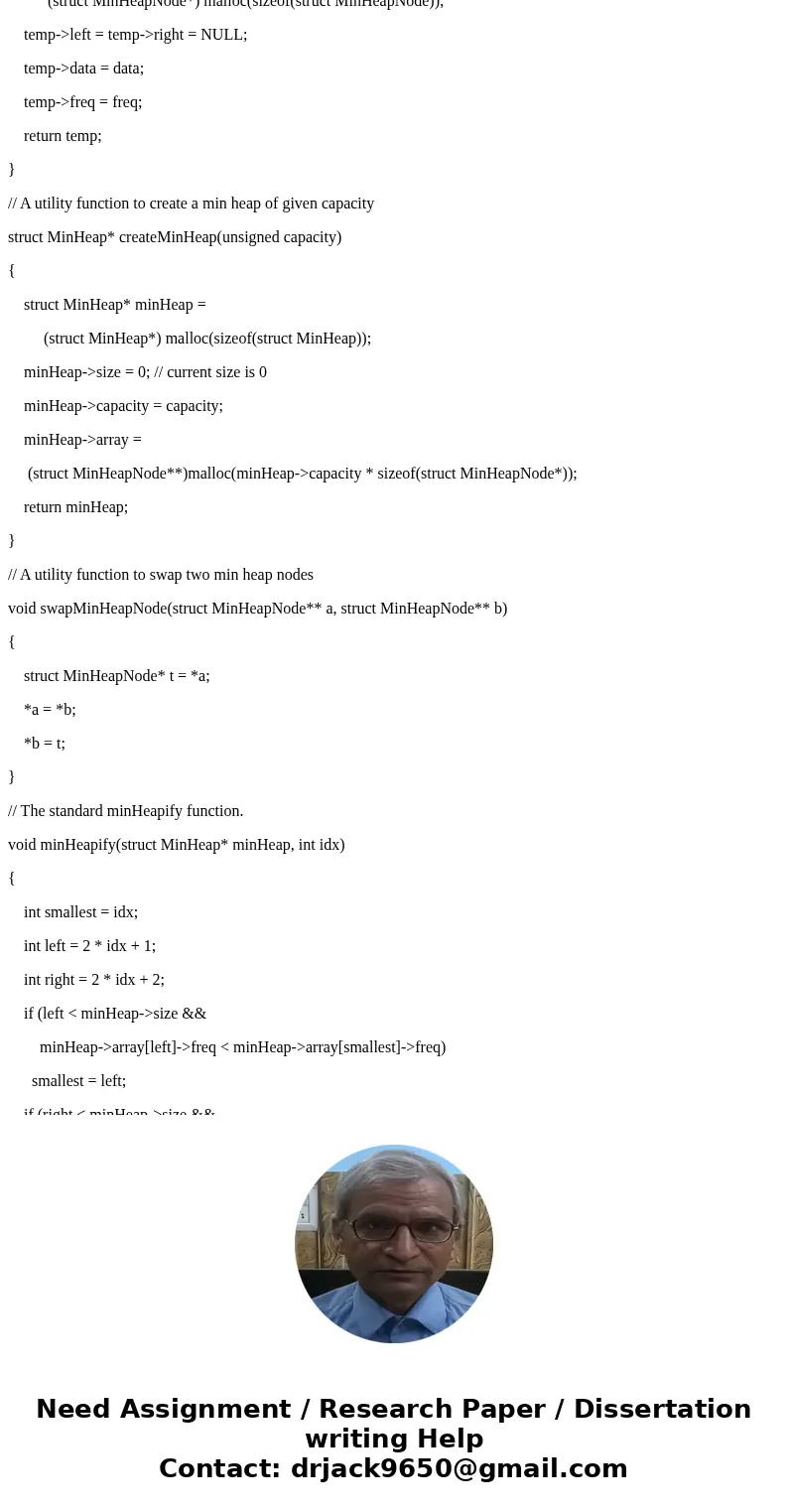
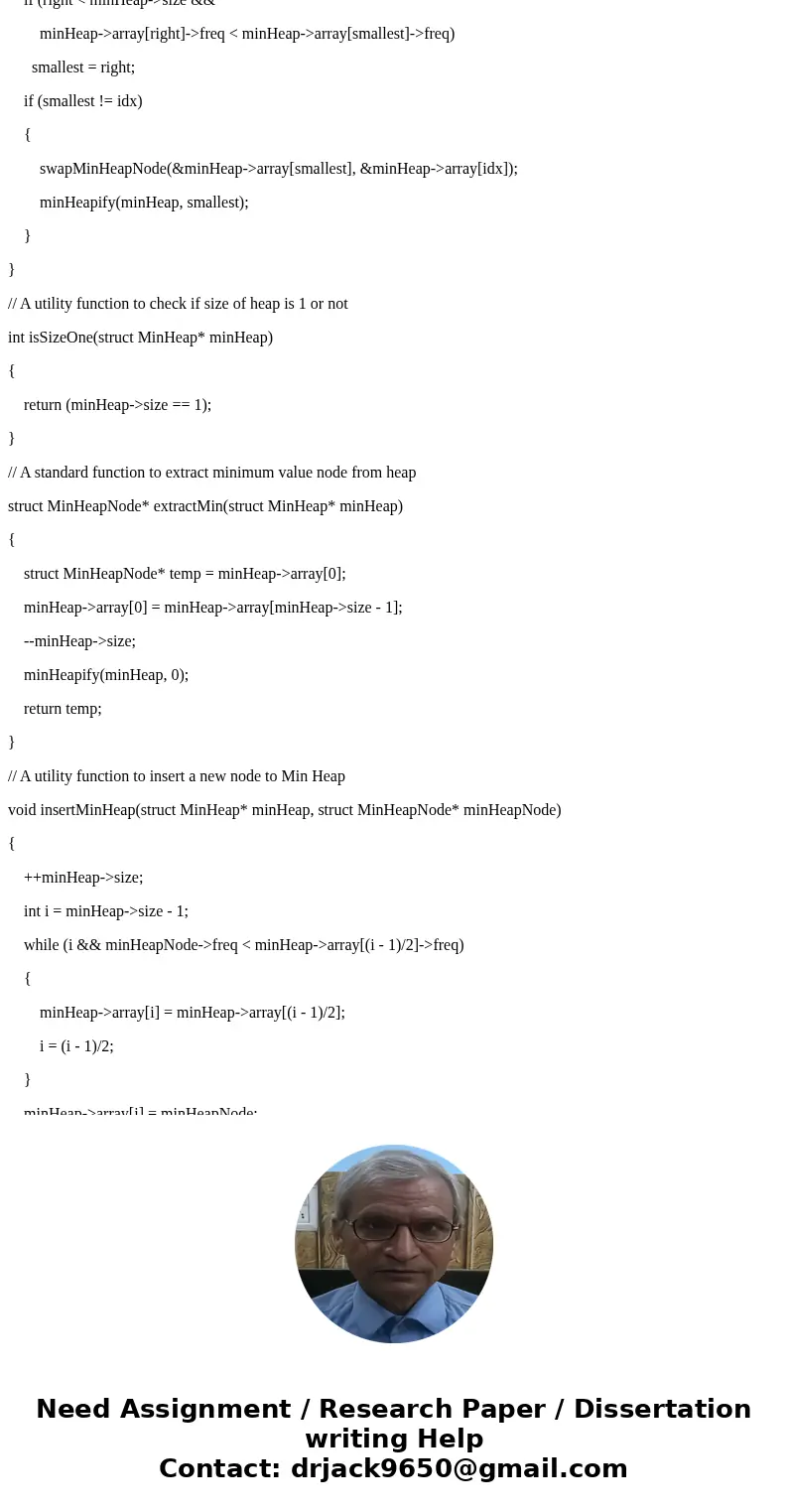

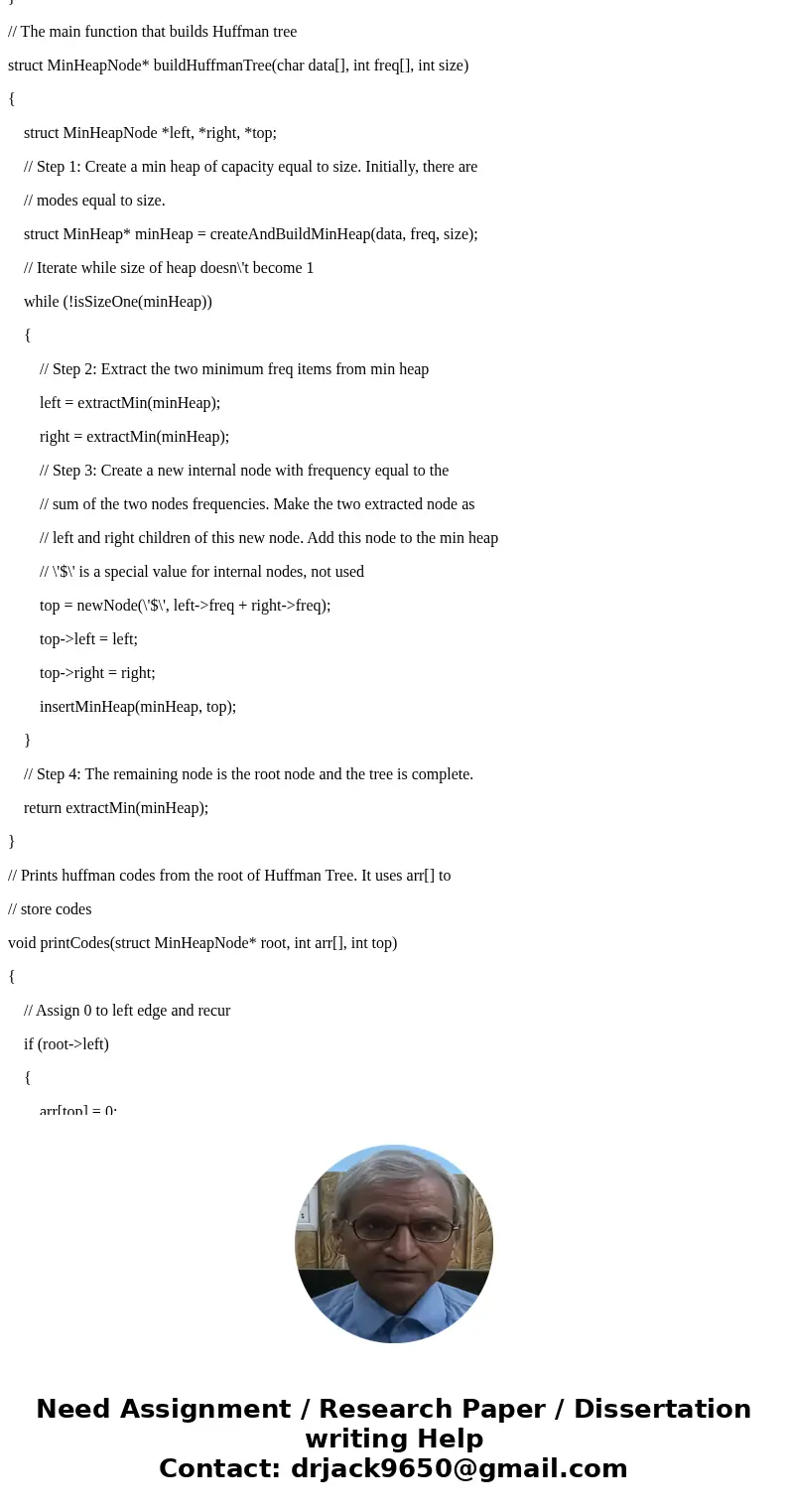
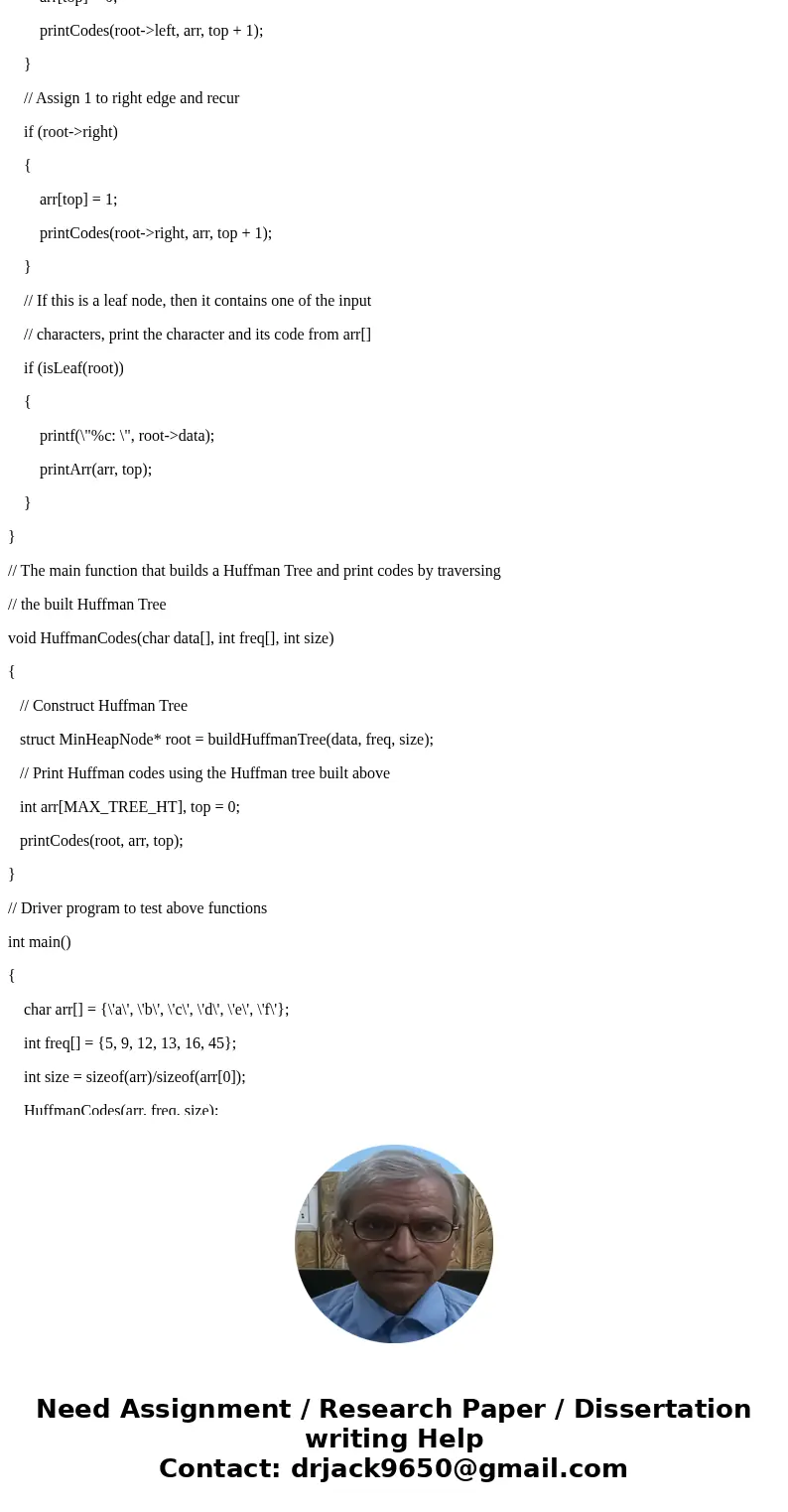

 Homework Sourse
Homework Sourse